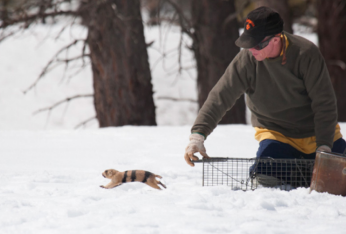
John Hoogland, biology professor at the University of Maryland Center for Environmental Science, had a busy couple of days before he arrived at Truman State University. Specifically, Hoogland needed to liquidate 800 traps and 11 observation towers, among other things, from his prairie dog field research assets.
“I am not going to be spending 6-7 months each year out there in the field watching prairie dogs,” Hoogland said. “So I stopped watching, and now I’ll start writing.”
Before returning home to begin his writing project, Hoogland gave a presentation at Truman, showcasing 45 years of prairie dog research to a packed lecture room Oct. 2 in Magruder Hall.
“I was really delighted that so many people came,” said Laura Fielden, biology professor and event organizer. “I think that students learned that Dr. John Hoogland is a world authority on prairie dogs, and he provided a wonderful introduction about the scientific process and what a field biologist does.”
Senior Bethany Travis invited Hoogland to speak at Truman. She said that Hoogland, who happens to be her uncle, is confidently himself and encourages other people to be themselves. He is also very passionate about what he does.
“It’s cool to Google his name and see him pop up in science journals,” Travis said. “I just think, ‘Oh, my uncle wrote that!’ Some of the stuff discovered through his research is new stuff, and it’s really exciting.”
Hoogland’s presentation highlighted some of his major findings over decades of prairie dog research including polyandry, infanticide and alarm calls. He conducted his research by catching, marking and watching prairie dogs.
The first major prairie dog discovery was polyandry. Hoogland said females were engaged in polyandry because it gives them clear advantages such as a higher likelihood of conceiving, producing and weaning a larger litter than if a female remained with one partner.
“The implication was that these results could not only apply to prairie dogs, but also to many other animals,” Hoogland said. “I can tap into over 40 years of data, so I’m able to test predictions with rigor.”
Hoogland then turned his attention to another big mystery: infanticide. He said prairie dogs were killing each other’s babies, specifically the offspring of close relatives.
Hoogland said he does not have a definitive answer for why this is happening because sample sizes are still relatively small, but he does have some ideas. Prairie dogs live in colonies where competition is extreme, especially in winter when food is scarce. Prairie dogs are usually herbivores, but killings occur when it is cold and there isn’t much plant material to consume. Surprisingly, the mothers do the killing because they are lactating and need protein, so they go into the burrows of other female prairie dogs and eat their babies.
“They get a good meal of protein, minerals, vitamins and maybe other kinds of rare elements that they might not get easily when they’re waiting for grass,” Hoogland said. “So then their babies have a slightly better chance of making it, but they’ll have to kill other prairie dog babies to get it.”
Observing prairie dogs also yielded another important discovery: alarm calls. Hoogland said alarm calls provide an advantage to group living because they can warn each other of predators such as badgers, bobcats, hawks, eagles and coyotes. Nonetheless, prairie dogs are their own worst enemy. Thirty-nine percent of all litters are killed, as noted with black-tailed prairie dogs, he said.
“So it really is a dog-eat-dog world,” Hoogland said with a laugh.
Hoogland’s research led him all over the western portion of the United States. He spent 15 years studying black-tailed prairie dogs in Wind Cave National Park in South Dakota, 13 years with the Gunnison’s prairie dogs in Petrified Forest National Park in Arizona, 10 years with the Utah prairie dogs at Bryce Canyon National Park and seven years with the white-tailed prairie dogs at the Arapaho National Wildlife Refuge in Colorado.
He said that he was lucky enough to wake up in beautiful places every morning to study prairie dog colonies and have the opportunity to see all kinds of other wildlife. Now, leaving field research after 45 years, he is looking forward to writing his magnum opus while still being physically and mentally sharp.
“I am fortunate and I had a wonderful run,” Hoogland said. “Most people don’t get to do what they want for 45 years. I did and I’m grateful for it. I’m excited to start working on a book now to summarize my time with prairie dogs.”
